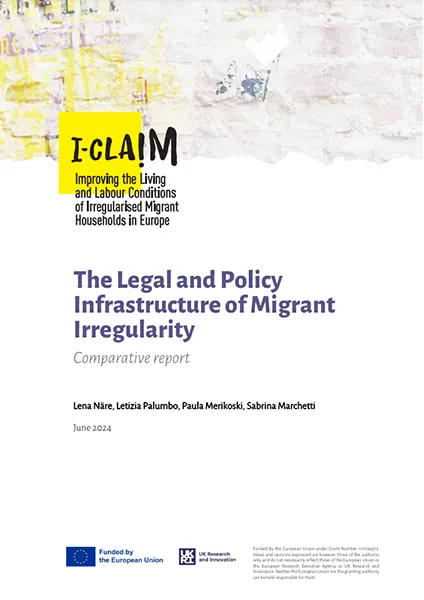The Legal and Policy Infrastructure of Migrant Irregularity. Comparative Report
Lena Näre, Letizia Palumbo, Paula Merikoski, Sabrina Marchetti
How to cite:
Näre, L., Palumbo, L., Merikoski, P., & Marchetti, S. (2024). The Legal and Policy Infrastructure of Migrant Irregularity. Comparative Report. I-CLAIM. DOI: https://zenodo.org/records/12564073
The Legal and Policy Infrastructure of Migrant Irregularity. Comparative Report
Lena Näre, Letizia Palumbo, Paula Merikoski, Sabrina Marchetti
This comparative report brings together the main findings of Work Package 3 of Improving the living and labour conditions of irregularised migrant households in Europe research project (I-CLAIM). This report examines the national policies and legislation that produce and shape irregular migration in six countries, Finland, Germany, Italy, the Netherlands, Poland and the United Kingdom, as well as at the EU level. It brings together findings from the six country reports, and a report examining EU policies.[1] The national reports and the EU report draw on the analysis of policy documents and written reports, as well as expert interviews conducted for this work package.
In this report, an irregular migrant is defined as a person, a non-citizen of the country of residence, who does not hold residence status in that country. This we term ‘administrative irregularity’. We also address the situation of individuals with a temporary and precarious legal status in the country of residence, using the term administrative precarity. It refers to a situation in which a person has a temporary and conditional legal status in the country of residence, such as being an asylum seeker with a pending removal order, or a person with a short-term and insecure legal status, such as a ‘tolerated stay permit’ (Duldung) in Germany. The main reason for adopting a more expansive definition of irregular migrant than strictly those without a valid residence permit is to capture the growing precarity and short-termism of immigration status, and the factors that intervene to make the situation of a growing number of immigrants ‘irregularisable’.
We found that in the six I-CLAIM countries, there is no single definition of an ‘irregular migrant’. Who counts as an irregular migrant varies across countries, across national, regional and local levels but also institutionally. Importantly, various institutions approach migrant irregularity differently, with important implications for its governance. While in the state-level governance of irregular migration the emphasis is commonly on internal security and home affairs, in practice, welfare and labour market policies and their implementation play a central role in shaping specific configurations of irregularity. Social and welfare policies govern migrant irregularity at the local level. The complexity of multi-level migration governance between local and national regulations, combined with the discretionary power of local bureaucrats, can produce differential treatment vis-à-vis individuals’ access to rights. We found that local governance of social and welfare policies is often in a conflicting relationship with how nation-states seek to control irregularised migrants’ access to social and welfare services. Cities and municipalities often take a more pragmatic approach and offer more extensive access to welfare services than the minimum national standards.
This discrepancy between policies emphasising internal security and border control and welfare policies is also evident in the way irregular migration is governed in the institutions of the European Union. Home affairs and criminalisation focus dominates the way irregularity is approached in the European Union. This has led to privileging measures that seek to increase the return rate, rather than policies on regularisation. We argue that the fact that regularisation of irregular migrants is a ‘no policy’ in the European Union is in itself a policy; we have termed this the EU’s ‘policy of no policy’ towards regularisation.
Although there is a strong policy emphasis on irregular border crossings and criminalisation of irregularity, the most common routes into irregularity in most I-CLAIM countries are administrative. The majority of irregularised migrants residing in these countries have entered the country through regular routes, for example as a worker or asylum seeker, and have subsequently lost their status or have been unable to have it renewed. The de facto presence of irregular migrants within the territories would warrant policy perspectives that privilege paths to regularisation.
Collective regularisation campaigns are important examples of the acknowledgement of this presence and such campaigns have been adopted in four of the I-CLAIM countries, of which some have concerned only a very targeted group of people (UK), and some have been larger in scale (IL, NL and PL). In addition to collective regularisation campaigns, which are rarely adopted and often are politically divisive, there are several individualised routes out of irregularity, many of which are highly precarious and short-term.
We argue that irregularity is often a process rather than a static state, as individual situations may change rapidly from regularity to irregularity and back, and individual household members might be of a different status. Moreover, irregularity is not an either-or situation. For example, migrants may reside legally in the country of residence but work outside the regulations of their residence permit, and thus be at significant risk of falling into irregularity. They might be EU citizens but lack access to basic welfare rights or employment protection in the country of residence. In this report, we attempt to unravel this complex interplay between various administrative situations and particular vulnerabilities that are created at the intersection of migration and labour laws and policies.
